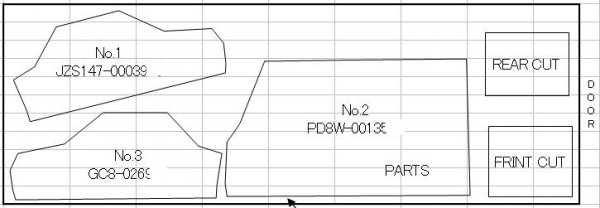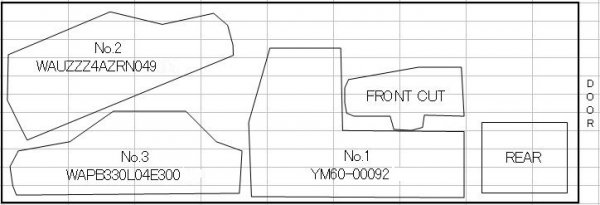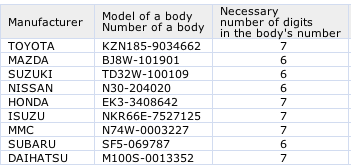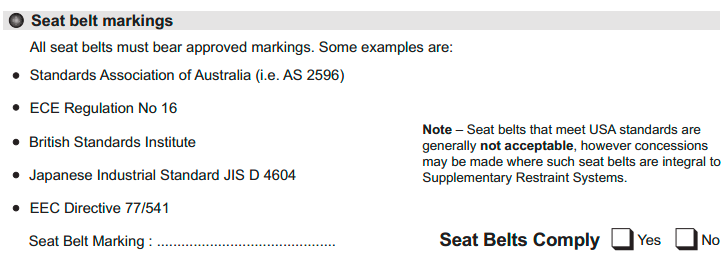MPI Mailer about JIS lights
Via HBeat (Barry with the Beat). I'm still trying to find an original or a scan, contact me if you have one. Update! scan is here: http://righthanddrive.ca/attachments/jisInManitoba.jpg
The mailer:
The vehicle Inspection Handbook is currently being reviewed to determine changes that may be required to address newer vehicle technologies and to provide even greater clarity of inspection standards and rejection criteria.
As part of this review, we have identified several issues related to lamps. Specifically, we have found that some vehicles that were originaly manufactured for markets outside of North America will be equipped with lamps that do not have either “DOT” or “SAE” codes. They may however, have either “JIS” or “E” codes, evidencing compliance with either Japanese or European standards.
HEADLAMPS-Transport Canada has approved the use of certain “E” coded headlamps in Canada. In situations where a vehicle is equipped with headlamps with an “E” code and:
1) An arrow symbol showing in both directions () – do not reject these headlamps simply because they do not have a “DOT/SAE?” marking; or
2) No arrow, do not reject simply because they do not have a “DOT/SAE” marking; or
3) An arrow symbol facing to the right (–>) REJECT as these lamps are not intended for right hand traffic roadways.
Lamps that do not display any “DOT/SAE” or “E” code must still be rejected.
LAMPS OTHER THAN HEADLAMPS – If you encounter any vehicle that has any lamp, other than a headlamp, that displays either “JIS” or “E” code and does not display a “DOT/SAE” code, please contact Vehicle Standards and Inspections (In Winnipeg at 985-0920 or toll free at 1-866-0542) to determine if the lamps will be rejected. Lamps that do not display any “DOT/SAE”, “E”, or “JIS” code must still be rejected. It is also important to be especially careful when inspecting vehicles with “E” or “JIS” codes as these lamp assemblies will sometimes not have all the required lamps that are normally found on vehicles built for the North American market e.g. tail lamp assemblies might not include side marker lamps/reflex reflectors.
Regardless of the coding(s) on any lamp or lamp assembly, if there are required lamps that are either missing or non-functional, they remain a cause for failure during an inspection.
JDM-less!
So, the Scoob is gone! I'm currently a poser, without a right hand drive car... running a right hand drive car website.
That aside... this is the next dream!

2.8L Pajero SWB
So, that's a Mitsubishi Pajero... with the 2.8L turbo diesel engine, and ideally a spoiler. I want the SWB (short wheel base... 2 door not 4 door) because I think it's awesome! Nothing like this has ever been sold in Canada. If you want a diesel engine you either get a GIGANTIC mall crawler, or a VW. I have deep love for VWs, but don't want a car right now.
I've already bid on this one:

I've named it Jesus (pronounced 'hey zeus')... Mexican Jesus. I didn't get it because of technical difficulties... my auction agent couldn't get on the server, and they wouldn't take bids any other way. Super lame. It didn't hit reserve, so it didn't sell... so it might be back (in 3 days?!?!?!), at which time, I'll bid on it again!
So... the auction and import fun start all over again. I'm excited!
Manitoba update!
MPI is accepting JIS non-headlight lighting! This is a big step forward to us.
E-code lighting is partially accepted now, too. They're being picky about a point I'm not totally clear on... I'm still trying to work that out.
This has been a long time coming, and is still unofficial. By the sounds of it, JIS non-headlight lighting will be accepted in the next edition of their safety standards... so they're allowing the lights on the road with that in mind.
This is not a win of the war, but definitely a win of the battle.
And, why have I been so quiet lately? Well, I just added 3 more letters behind my name this month... so I've been busy doing bureaucratic nonsense.
I'll try to kick it up a notch now that I'm done that....
Cheers,
Rob Guderian, M.Sc.
730
If you visit this website with any frequency, chances are you're interested in driving laws/rules and idioms in general. You've probably asked the question, "Why do some countries drive on the left side of the road?". Well. Because Britain did, and they had HUGE influence on the world back in the days of colonization.
Think about countries that drive on the left. Jamaica, Cayman Islands, Australia, India, South Africa... the list goes on... all former colonies. Now. What about the source of all of Canada's RHD imports? Japan.
Well, Japan was occupied by Britain after World War II, which is a common thing to make sure the country that lost the war doesn't start it right back up again. So, driving on the left became the traffic laws.
But one island was occupied by the USA... so that island, which was (and is) owned by Japan was made to drive on the right!
Now, turns out there's a Geneva Convention on Road Traffic! From Geneva Convention on Road Traffic (1949):
All vehicular traffic proceeding in the same direction on any road shall keep to the same side of the road, which shall be uniform in each country for all roads
So, this island was in violation of this convention. So, they switched the side of the road the island drove on... in one day.
The islanders we not allowed do drive starting at 10pm on July 29, 1978. Overnight, all the signs changed sides of the roads, bus stops were moved and a lot of work was done.
The next day, July 30th (7th month, 30th day.... hence 730) people were allowed back on the road at 6am. The island brought in loads of police to help with the potential disaster that would ensue. And, from that day forward, all of Japan drove on the same side of the road!
LHD cars were then called 729 cars, and RHD cars were .... well, just cars!
Amazing story!
Sources:
Wikipedia
More Wikipedia
Importing, going the other way
If you're on this site, chances are you're interested in importing cars from Japan, but have you ever thought it'd go the other way? I keep saying, "None of the good cars were sold here".... then I found this.
Jeremy Clarkson (with his 90s poofy hairdo) is in the USA extolling the amazing cars that they can import for almost nothing. Sounds familiar, doesn't it?
Then, you can see how good we have it. Sure the UK can import any car, but they have to, and I quote, "Pay tax, on the tax, on the tax". They get taxed many more times than we do when we import cars. We don't get off that much easier, but the people in the UK have to pay 17.5% 'Value added tax' on the purchase price, plus the taxes they paid. We get dinged at the border, and when we insure... but that's pretty reasonable in comparison.
Also, it sounds like there is an exemption date for them to import cars without duty... which is somewhat like our 'RIV exempt' 15 year rule (which also gives us the opportunity to buy the cars we actually want).
Container Packing – Madman’s Tetris
It's pretty common knowledge that cars shipped from Japan didn't drive to their final destination. So, that means the car was shipped somehow.
When shipping cars from Japan, there is a 'stuffing' and 'destuffing' fee, which is a fee to get some one to put your car in, then later take your car out of a shipping container. The fee is a few hundred dollars both times.... now that seems like a lot.... Until you see what the containers look like when it's all said an done.
I took these images from Brave Auto's site (here and here - worth a read!) where they are discussing half cuts (a post on it's own). In short, one of the cars is cut in half in the container. You can see in the images that cars hang from ropes over other cars. This is to utilize all the possible space in the container to bring down the shipping costs per car.
While talking about container shipping cars, Mark at Brave Auto mentioned that it's generally easy to get the cars into the container, but quite difficult to get the cars OUT of the container without damaging them. This surprised me, but after thinking about it.... you're lowering a 2-3 ton car which is hanging dangerously close to other cars.... it's a recipe for disaster! So, Brave auto tries to leave room in the container even though another car could be shoehorned into the container. Doing this lowers the chances that a car is damaged while putting the cars in or taking the cars out.
A tense moment…
Got this in the mail yesterday:
Now, this is tense since MPI is known to call in cars for re-inspection (free of charge!), where they'll re-check all the compliance items that imported cars must adhere to. It's happened to a few of my friends, but I've not been called in yet. So, I was thinking this might be a precursor to it.... luckily it's not. So, what was this for? Well...
A VIN (Vehicle Identification Number) is a North American invention. A VIN is a 17 digit number, with a few different conventions on what the numbers mean.
JDM vehicles ship with a chassis code (or frame number).
As seen here, the codes can be of varying lengths, ranging from 9-12 digits. Also, this is where the chassis number comes from! The model is the first few alphanumeric digits. My Subaru's number is GC8-xxxxxxx, my Hijet was S83P-xxxxxxxx. An 'S13' Silva would be S13-xxxxxxx. Super cool!
There should be a plate on every JDM car listing the model number, chassis code, engine number and transmission number. It's quite informative and interesting to look at. Check it out on your car, or your friend's car!
BC's public insurer (ICBC) provides 17 digit VINs to their customers, while Manitoba's (MPI) doesn't. So, apparently they'll occasionally check in to make sure it's still the same number. Make work project!
Conversation with the Deputy Minister of Infrastructure and Transportation
Here's an update on the world's slowest conversation.
This was my letter to the minister:
Mr McNeil,
First of all, thank you for your thoughtful reply. I appreciate the time you took to respond to my mail. I apologize for the time it has taken me to get back to you.
Though MPI administers the law, the legislature makes the laws. I agree that MPI is a stakeholder and should be an active member in the conversation about changes to any vehicle safety standards, but the changes must take place at a higher level. I have had a meeting with some MPI staff, and they have been very helpful answering my questions and meeting with me, but I feel that these changes are beyond their jurisdiction.
But, the problem as I see it is that Manitoba is falling behind the times in terms of vehicle safety. The world is getting smaller, and it is becoming easier for regular folk to import the cars of their dreams from other countries. I don't see this as a passing fad, and I believe that it should be looked at and handled sooner rather than later.
The most important part of the argument is that it is absurd and archaic that ECE coded (e-coded) lighting is not accepted in Manitoba. This is a world standard that has been accepted in the Motor Vehicle Safety Act (http://www.tc.gc.ca/eng/acts-regulations/regulations-crc-c1038-sch-iv-108.1.htm), and a precedent has been set by allowing vehicles such as Mercedes Benz into the country, as they have no DOT markings, but only ECE markings. Clearly proper e-codes for left-hand drive countries must be marked on the headlights, but all ECE markings should be accepted for non-headlight lighting.
Accepting ECE markings will not make the vehicles less safe, and bring Manitoba up to the world standard for safety.
ICBC, the public insurer for British Columbia has already implemented some of these changes, including accepting JIS (Japanese standards) to the fold. Accepting national standards from other 1st world countries makes sense in this which is getting smaller. I understand that not every vehicle should be permitted on Manitoban roads (the autorickshaw from India comes to mind), but accepting other-national standards for imported cars (15 years or older) makes sense for this ever-shrinking world.
I've attached my full technical document again for your perusal, as I believe it outlines my argument well.
Thank you again for your time.
Robert Guderian
Concise and polite, I'd say.
This is the minister's response:
Dear Mr. Guderian:
I am responding to your January 6, 2012 e-mail regarding your interest in Manitoba's vehicle equipment laws in relation to grey imports. I am pleased that you have found Manitoba Public Insurance (MPI) to be helpful in addressing some of your concerns regarding this matter.
I appreciate your comments affirming that the Manitoba Legislature has jurisdiction over the creation and amendment of provincial statutes. In doing so, guidance and advice is sought from various stakeholders. Stakeholder recommendations are taken into consideration; however, as you rightly stated in your correspondence, the decision for legislative or regulatory changes ultimately lies with Government.
Manitoba Public Insurance has been requested by the Government of Manitoba to review Manitoba's equipment standards in relation to grey imports. Manitoba Public Insurance is in the process of reviewing the European and Japanese vehicle lighting standards and will inform Manitoba Infrastructure and Transportation of their findings and recommendations regarding this matter. Please be assured that MPI's assistance with this does not preclude consideration being given to information provided by other equally valuable sources. Manitoba Infrastructure and Transportation is currently examining all of Manitoba's vehicle equipment requirements with a view to ensuring that they are current. The information you provided will be given full consideration in the overall review of these standards. Your patience while the review is being conducted is greatly appreciated.
I hope you find this information helpful.
Sincerely,
Doug McNeil, M. Eng., P. Eng.
Deputy Minister of Manitoba Infrastructure and Transportationc. Honourable Steve Ashton
Honourable Andrew Swan
Mr. Ward Keith
It's a nice way of saying, "Yes, you're right, now bugger off". At first they say "Go talk to MPI, they'll help you". So, I point out that MPI is no the person I want to talk to, I want to talk to the people making the changes... to which they say, "Yeah, you're right, that's us!".
I'm not sure how to approach this now. My plan is to point out that JIS parts are better than DOT, and Australia has already done this work for us. And, want to raise the issue of seatbelts too, but I also want to stay focused on one topic. Really, too much to do and too little time.
Thoughts, anyone?
Rob
JIS Seatbelts, provably better than DOT
Actually, Australia (an importer of JDM cars for obvious reasons) will happily accept JIS marked seatbelts... but not DOT. Check it out. This is the import form filled out by the mechanics doing a 'rego' (registration, OOP, safety... whatever you want to call it), and Australia is very strict about their compliance.
Here's a fun image from the sheet they fill out.
Check that out... DOT is, quote, "Generally not accepted". That's awesome. Clearly someone in Australia did the work to prove that DOT seatbelts are not as good as JIS seatbelts.
The reason this came up, is Rob Reimer (hereby known as 'Mr. Awesome') was clever enough to look at Australia's import standards... they have comparable standards to Canada in many respects, so what about this one. Brilliant.
Mr. Awesome posted as a comment on 'Meeting with MPI - the details':
According to FMVSS 209, a seat belt must withstand no less than 22689 N of force on the overall assembly, where the JIS standard insists on no less than 22700 N. A somewhat minor difference, I concede, but the fact remains that the standard is at the very least comparable.
And, the translated JIS document: is here. (Though, I could use a better copy). And here's the Japanese original.
So, now I have more ammunition to use against MPI. Amazing. I'm still deciding how to use this new knowledge. If I should bring it up with MPI, or take it to the MLAs. I think MPI is where I'll start, as I have a contact there. Any suggestions?
My Japanese-speaking turbo timer
When importing a car from a different continent, you might get some unusual goodies along with it. My friends have found Japanese Yen, subway tickets, cigarette packs, and random notes. You also might get goodies like turbo timers, blow-off valves and other engine tweaks.
My favourite goodie is my turbo timer. It speaks Japanese when I turn the car on or off (if the timer is on). For a long time I didn't know what it was saying. I took a Japanese course at university (I needed some arts credits, and, why not?) and all I knew was that she was saying 'something something is ok'.
It got funnier as time went on, as I knew the rhythm and tune she said her sentences, but not what she was saying.
And here it is!
My friend was kind enough to translate for me, you can see it in the youtube comments.
Standby: OK Desu (Standby is ok)
Countdown: Starto shimasu. (Starting countdown)
Pretty fun to have these quirky things with your pretty unique import.
Thanks "foomeister2347"!




